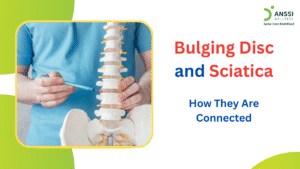Sciatic pain is a common yet debilitating condition that affects millions of people worldwide. Many of us experiencing radiating pain from the lower back down to the leg assume that it’s a herniated disc. However, sciatica is a symptom, not a condition itself, and it can stem from multiple causes, one of which is piriformis syndrome.
Piriformis syndrome is often mistaken for a herniated disc because both conditions compress the sciatic nerve, leading to similar pain patterns. But there are substantial differences in their causes, symptoms, and therapies. Understanding the distinction between these conditions is crucial for finding the right treatment and achieving long-term relief.
What is Piriformis Syndrome?
Deep within the buttocks lies a tiny but crucial muscle called the piriformis. It plays a key role in hip rotation and stabilising movement. The sciatic nerve, the largest nerve in the body, runs underneath or, in some cases, directly through the piriformis muscle.
Piriformis syndrome occurs when the piriformis muscle becomes tight, inflamed, or spasms, leading to compression of the sciatic nerve. This compression causes symptoms similar to sciatica, including radiating pain, numbness, and tingling down the leg. Unlike a herniated disc, which originates in the spine, piriformis syndrome is a muscular issue.
Herniated Disc vs. Piriformis Syndrome
Because both conditions affect the sciatic nerve, they share overlapping symptoms. However, their causes and mechanisms of nerve compression differ.
How Nerve Compression Occurs
- Herniated Disc: When a spinal disc bulges or ruptures, it can press on the nerve roots exiting the spinal column, leading to sciatica symptoms.
- Piriformis Syndrome: The piriformis muscle becomes overly tight or inflamed, causing direct compression of the sciatic nerve as it passes through or beneath the muscle.
Differences in Causes and Symptoms
In the case of a herniated disc:
- Cause: Spinal disc bulging or rupturing, pressing on nerve roots
- Location of Pain: Radiates down the leg from the lower back
- Pain Triggers: Bending, sitting, or lifting heavy objects
- Numbness/Tingling: More likely to affect the foot and toes
- Weakness: May cause leg weakness due to nerve root compression
In the case of piriformis syndrome:
- Cause: Tightness, inflammation, or spasms of the piriformis muscle
- Location of Pain: Begins in the buttock and spreads down the leg
- Pain Triggers: Prolonged sitting, climbing stairs, or running
- Numbness/Tingling: Primarily in the buttock and upper thigh
- Weakness: Muscle tightness but no direct spinal involvement
Since both conditions result in sciatic pain, misdiagnosis is common. However, understanding the source of compression helps determine the most effective treatment approach.
Symptoms of Piriformis Syndrome
People with piriformis syndrome often experience the following:
- Deep buttock pain: A dull or sharp pain in the centre of the buttocks.
- Pain that radiates down the leg: Sciatic-like pain extending to the thigh or calf.
- Tingling or numbness: A pins-and-needles sensation in the leg.
- Increased pain with movement: Sitting for long periods, climbing stairs, or engaging in activities like running can worsen symptoms.
- Muscle tightness or spasms: The piriformis muscle may feel tense and sore.
Unlike a herniated disc, piriformis syndrome rarely causes lower back pain and does not typically involve leg weakness.
Diagnosis and Identification
Proper diagnosis is essential to differentiate between piriformis syndrome and a herniated disc.
Diagnostic Tests and Physical Exams
A doctor or physiotherapist may use:
- Medical history review: Understanding when and how the pain started.
- Physical examination: Checking for muscle tightness, tenderness, and movement limitations.
- Piriformis Test: The patient lies on their back with one leg crossed over the other, and the doctor gently presses on the knee to assess pain response.
- MRI or CT scan: To rule out spinal disc issues or nerve root compression.
If imaging tests do not reveal a herniated disc but the patient still experiences sciatic pain, piriformis syndrome may be the cause.
Treatment Options
Since piriformis syndrome is a muscular condition, treatment focuses on relieving muscle tension, reducing inflammation, and improving mobility.
1. Stretching and Mobility Exercises
Stretching the piriformis muscle helps release tension and relieve sciatic nerve compression.
Effective stretches include:
- Piriformis Stretch: Lying on your back, pulling the affected leg toward the opposite shoulder.
- Seated Figure-Four Stretch: Sitting with one ankle crossed over the opposite knee and leaning forward.
2. Physiotherapy
A trained physiotherapist can provide guidance for targeted exercises, massage therapy, and movement correction to reduce muscle tightness and restore proper function.
3. Non-Surgical Spinal Decompression Treatment
Although piriformis syndrome is a muscular issue, spinal decompression treatment can still be beneficial in certain cases, especially if there is co-existing spinal misalignment.
How It Works: A specialised decompression table gently stretches the spine, relieving pressure on spinal discs and nerves.
Why It Helps: If piriformis syndrome is aggravated by poor spinal alignment, decompression treatment can help restore proper posture and reduce muscle strain.
4. Other Treatment Approaches
- Heat and Ice Therapy: Helps relax muscles and reduce inflammation.
- Massage Therapy: Deep tissue massage can relieve muscle tension in the piriformis.
- Postural Corrections: Ensuring ergonomic sitting positions can prevent piriformis irritation.
About ANSSI:
ANSSI Wellness focuses on improving the quality of life for patients suffering from spinal issues, aiming to provide relief where other conventional treatments have failed. Through advanced non-surgical spinal decompression treatment, ANSSI is committed to helping patients avoid surgery and recover in a safe, effective, and compassionate environment.
Connect with ANSSI Wellness on LinkedIn, Instagram, and Facebook for expert guidance.



